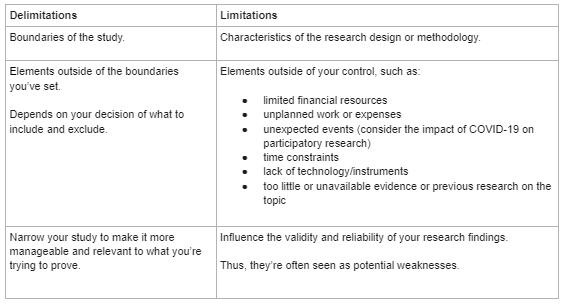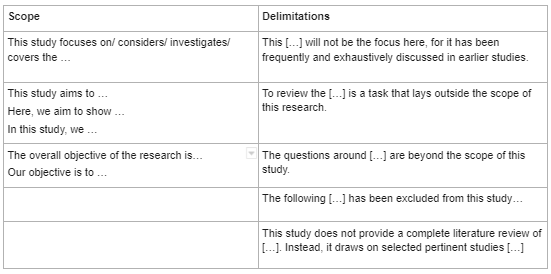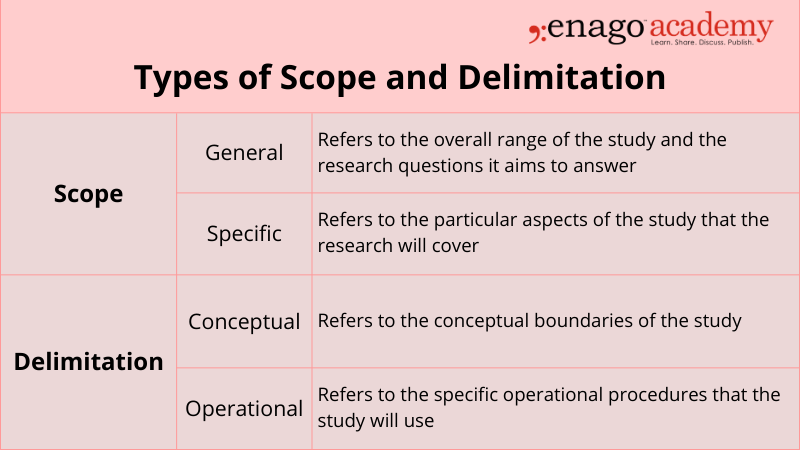- Privacy Policy

Home » Delimitations in Research – Types, Examples and Writing Guide

Delimitations in Research – Types, Examples and Writing Guide
Table of Contents

Delimitations
Definition:
Delimitations refer to the specific boundaries or limitations that are set in a research study in order to narrow its scope and focus. Delimitations may be related to a variety of factors, including the population being studied, the geographical location, the time period, the research design , and the methods or tools being used to collect data .
The Importance of Delimitations in Research Studies
Here are some reasons why delimitations are important in research studies:
- Provide focus : Delimitations help researchers focus on a specific area of interest and avoid getting sidetracked by tangential topics. By setting clear boundaries, researchers can concentrate their efforts on the most relevant and significant aspects of the research question.
- Increase validity : Delimitations ensure that the research is more valid by defining the boundaries of the study. When researchers establish clear criteria for inclusion and exclusion, they can better control for extraneous variables that might otherwise confound the results.
- Improve generalizability : Delimitations help researchers determine the extent to which their findings can be generalized to other populations or contexts. By specifying the sample size, geographic region, time frame, or other relevant factors, researchers can provide more accurate estimates of the generalizability of their results.
- Enhance feasibility : Delimitations help researchers identify the resources and time required to complete the study. By setting realistic parameters, researchers can ensure that the study is feasible and can be completed within the available time and resources.
- Clarify scope: Delimitations help readers understand the scope of the research project. By explicitly stating what is included and excluded, researchers can avoid confusion and ensure that readers understand the boundaries of the study.
Types of Delimitations in Research
Here are some types of delimitations in research and their significance:
Time Delimitations
This type of delimitation refers to the time frame in which the research will be conducted. Time delimitations are important because they help to narrow down the scope of the study and ensure that the research is feasible within the given time constraints.
Geographical Delimitations
Geographical delimitations refer to the geographic boundaries within which the research will be conducted. These delimitations are significant because they help to ensure that the research is relevant to the intended population or location.
Population Delimitations
Population delimitations refer to the specific group of people that the research will focus on. These delimitations are important because they help to ensure that the research is targeted to a specific group, which can improve the accuracy of the results.
Data Delimitations
Data delimitations refer to the specific types of data that will be used in the research. These delimitations are important because they help to ensure that the data is relevant to the research question and that the research is conducted using reliable and valid data sources.
Scope Delimitations
Scope delimitations refer to the specific aspects or dimensions of the research that will be examined. These delimitations are important because they help to ensure that the research is focused and that the findings are relevant to the research question.
How to Write Delimitations
In order to write delimitations in research, you can follow these steps:
- Identify the scope of your study : Determine the extent of your research by defining its boundaries. This will help you to identify the areas that are within the scope of your research and those that are outside of it.
- Determine the time frame : Decide on the time period that your research will cover. This could be a specific period, such as a year, or it could be a general time frame, such as the last decade.
- I dentify the population : Determine the group of people or objects that your study will focus on. This could be a specific age group, gender, profession, or geographic location.
- Establish the sample size : Determine the number of participants that your study will involve. This will help you to establish the number of people you need to recruit for your study.
- Determine the variables: Identify the variables that will be measured in your study. This could include demographic information, attitudes, behaviors, or other factors.
- Explain the limitations : Clearly state the limitations of your study. This could include limitations related to time, resources, sample size, or other factors that may impact the validity of your research.
- Justify the limitations : Explain why these limitations are necessary for your research. This will help readers understand why certain factors were excluded from the study.
When to Write Delimitations in Research
Here are some situations when you may need to write delimitations in research:
- When defining the scope of the study: Delimitations help to define the boundaries of your research by specifying what is and what is not included in your study. For instance, you may delimit your study by focusing on a specific population, geographic region, time period, or research methodology.
- When addressing limitations: Delimitations can also be used to address the limitations of your research. For example, if your data is limited to a certain timeframe or geographic area, you can include this information in your delimitations to help readers understand the limitations of your findings.
- When justifying the relevance of the study : Delimitations can also help you to justify the relevance of your research. For instance, if you are conducting a study on a specific population or region, you can explain why this group or area is important and how your research will contribute to the understanding of this topic.
- When clarifying the research question or hypothesis : Delimitations can also be used to clarify your research question or hypothesis. By specifying the boundaries of your study, you can ensure that your research question or hypothesis is focused and specific.
- When establishing the context of the study : Finally, delimitations can help you to establish the context of your research. By providing information about the scope and limitations of your study, you can help readers to understand the context in which your research was conducted and the implications of your findings.
Examples of Delimitations in Research
Examples of Delimitations in Research are as follows:
Research Title : “Impact of Artificial Intelligence on Cybersecurity Threat Detection”
Delimitations :
- The study will focus solely on the use of artificial intelligence in detecting and mitigating cybersecurity threats.
- The study will only consider the impact of AI on threat detection and not on other aspects of cybersecurity such as prevention, response, or recovery.
- The research will be limited to a specific type of cybersecurity threats, such as malware or phishing attacks, rather than all types of cyber threats.
- The study will only consider the use of AI in a specific industry, such as finance or healthcare, rather than examining its impact across all industries.
- The research will only consider AI-based threat detection tools that are currently available and widely used, rather than including experimental or theoretical AI models.
Research Title: “The Effects of Social Media on Academic Performance: A Case Study of College Students”
Delimitations:
- The study will focus only on college students enrolled in a particular university.
- The study will only consider social media platforms such as Facebook, Twitter, and Instagram.
- The study will only analyze the academic performance of students based on their GPA and course grades.
- The study will not consider the impact of other factors such as student demographics, socioeconomic status, or other factors that may affect academic performance.
- The study will only use self-reported data from students, rather than objective measures of their social media usage or academic performance.
Purpose of Delimitations
Some Purposes of Delimitations are as follows:
- Focusing the research : By defining the scope of the study, delimitations help researchers to narrow down their research questions and focus on specific aspects of the topic. This allows for a more targeted and meaningful study.
- Clarifying the research scope : Delimitations help to clarify the boundaries of the research, which helps readers to understand what is and is not included in the study.
- Avoiding scope creep : Delimitations help researchers to stay focused on their research objectives and avoid being sidetracked by tangential issues or data.
- Enhancing the validity of the study : By setting clear boundaries, delimitations help to ensure that the study is valid and reliable.
- Improving the feasibility of the study : Delimitations help researchers to ensure that their study is feasible and can be conducted within the time and resources available.
Applications of Delimitations
Here are some common applications of delimitations:
- Geographic delimitations : Researchers may limit their study to a specific geographic area, such as a particular city, state, or country. This helps to narrow the focus of the study and makes it more manageable.
- Time delimitations : Researchers may limit their study to a specific time period, such as a decade, a year, or a specific date range. This can be useful for studying trends over time or for comparing data from different time periods.
- Population delimitations : Researchers may limit their study to a specific population, such as a particular age group, gender, or ethnic group. This can help to ensure that the study is relevant to the population being studied.
- Data delimitations : Researchers may limit their study to specific types of data, such as survey responses, interviews, or archival records. This can help to ensure that the study is based on reliable and relevant data.
- Conceptual delimitations : Researchers may limit their study to specific concepts or variables, such as only studying the effects of a particular treatment on a specific outcome. This can help to ensure that the study is focused and clear.
Advantages of Delimitations
Some Advantages of Delimitations are as follows:
- Helps to focus the study: Delimitations help to narrow down the scope of the research and identify specific areas that need to be investigated. This helps to focus the study and ensures that the research is not too broad or too narrow.
- Defines the study population: Delimitations can help to define the population that will be studied. This can include age range, gender, geographical location, or any other factors that are relevant to the research. This helps to ensure that the study is more specific and targeted.
- Provides clarity: Delimitations help to provide clarity about the research study. By identifying the boundaries and limitations of the research, it helps to avoid confusion and ensures that the research is more understandable.
- Improves validity: Delimitations can help to improve the validity of the research by ensuring that the study is more focused and specific. This can help to ensure that the research is more accurate and reliable.
- Reduces bias: Delimitations can help to reduce bias by limiting the scope of the research. This can help to ensure that the research is more objective and unbiased.
About the author
Muhammad Hassan
Researcher, Academic Writer, Web developer
You may also like

Tables in Research Paper – Types, Creating Guide...

Research Approach – Types Methods and Examples

Dissertation – Format, Example and Template

Research Paper Title Page – Example and Making...

Research Paper Title – Writing Guide and Example

Research Paper Introduction – Writing Guide and...
Scope and Delimitations in Research
Delimitations are the boundaries that the researcher sets in a research study, deciding what to include and what to exclude. They help to narrow down the study and make it more manageable and relevant to the research goal.
Updated on October 19, 2022

All scientific research has boundaries, whether or not the authors clearly explain them. Your study's scope and delimitations are the sections where you define the broader parameters and boundaries of your research.
The scope details what your study will explore, such as the target population, extent, or study duration. Delimitations are factors and variables not included in the study.
Scope and delimitations are not methodological shortcomings; they're always under your control. Discussing these is essential because doing so shows that your project is manageable and scientifically sound.
This article covers:
- What's meant by “scope” and “delimitations”
- Why these are integral components of every study
- How and where to actually write about scope and delimitations in your manuscript
- Examples of scope and delimitations from published studies
What is the scope in a research paper?
Simply put, the scope is the domain of your research. It describes the extent to which the research question will be explored in your study.
Articulating your study's scope early on helps you make your research question focused and realistic.
It also helps decide what data you need to collect (and, therefore, what data collection tools you need to design). Getting this right is vital for both academic articles and funding applications.
What are delimitations in a research paper?
Delimitations are those factors or aspects of the research area that you'll exclude from your research. The scope and delimitations of the study are intimately linked.
Essentially, delimitations form a more detailed and narrowed-down formulation of the scope in terms of exclusion. The delimitations explain what was (intentionally) not considered within the given piece of research.
Scope and delimitations examples
Use the following examples provided by our expert PhD editors as a reference when coming up with your own scope and delimitations.
Scope example
Your research question is, “What is the impact of bullying on the mental health of adolescents?” This topic, on its own, doesn't say much about what's being investigated.
The scope, for example, could encompass:
- Variables: “bullying” (dependent variable), “mental health” (independent variable), and ways of defining or measuring them
- Bullying type: Both face-to-face and cyberbullying
- Target population: Adolescents aged 12–17
- Geographical coverage: France or only one specific town in France
Delimitations example
Look back at the previous example.
Exploring the adverse effects of bullying on adolescents' mental health is a preliminary delimitation. This one was chosen from among many possible research questions (e.g., the impact of bullying on suicide rates, or children or adults).
Delimiting factors could include:
- Research design : Mixed-methods research, including thematic analysis of semi-structured interviews and statistical analysis of a survey
- Timeframe : Data collection to run for 3 months
- Population size : 100 survey participants; 15 interviewees
- Recruitment of participants : Quota sampling (aiming for specific portions of men, women, ethnic minority students etc.)
We can see that every choice you make in planning and conducting your research inevitably excludes other possible options.
What's the difference between limitations and delimitations?
Delimitations and limitations are entirely different, although they often get mixed up. These are the main differences:

This chart explains the difference between delimitations and limitations. Delimitations are the boundaries of the study while the limitations are the characteristics of the research design or methodology.
Delimitations encompass the elements outside of the boundaries you've set and depends on your decision of what yo include and exclude. On the flip side, limitations are the elements outside of your control, such as:
- limited financial resources
- unplanned work or expenses
- unexpected events (for example, the COVID-19 pandemic)
- time constraints
- lack of technology/instruments
- unavailable evidence or previous research on the topic
Delimitations involve narrowing your study to make it more manageable and relevant to what you're trying to prove. Limitations influence the validity and reliability of your research findings. Limitations are seen as potential weaknesses in your research.
Example of the differences
To clarify these differences, go back to the limitations of the earlier example.
Limitations could comprise:
- Sample size : Not large enough to provide generalizable conclusions.
- Sampling approach : Non-probability sampling has increased bias risk. For instance, the researchers might not manage to capture the experiences of ethnic minority students.
- Methodological pitfalls : Research participants from an urban area (Paris) are likely to be more advantaged than students in rural areas. A study exploring the latter's experiences will probably yield very different findings.
Where do you write the scope and delimitations, and why?
It can be surprisingly empowering to realize you're restricted when conducting scholarly research. But this realization also makes writing up your research easier to grasp and makes it easier to see its limits and the expectations placed on it. Properly revealing this information serves your field and the greater scientific community.
Openly (but briefly) acknowledge the scope and delimitations of your study early on. The Abstract and Introduction sections are good places to set the parameters of your paper.
Next, discuss the scope and delimitations in greater detail in the Methods section. You'll need to do this to justify your methodological approach and data collection instruments, as well as analyses
At this point, spell out why these delimitations were set. What alternative options did you consider? Why did you reject alternatives? What could your study not address?
Let's say you're gathering data that can be derived from different but related experiments. You must convince the reader that the one you selected best suits your research question.
Finally, a solid paper will return to the scope and delimitations in the Findings or Discussion section. Doing so helps readers contextualize and interpret findings because the study's scope and methods influence the results.
For instance, agricultural field experiments carried out under irrigated conditions yield different results from experiments carried out without irrigation.
Being transparent about the scope and any outstanding issues increases your research's credibility and objectivity. It helps other researchers replicate your study and advance scientific understanding of the same topic (e.g., by adopting a different approach).
How do you write the scope and delimitations?
Define the scope and delimitations of your study before collecting data. This is critical. This step should be part of your research project planning.
Answering the following questions will help you address your scope and delimitations clearly and convincingly.
- What are your study's aims and objectives?
- Why did you carry out the study?
- What was the exact topic under investigation?
- Which factors and variables were included? And state why specific variables were omitted from the research scope.
- Who or what did the study explore? What was the target population?
- What was the study's location (geographical area) or setting (e.g., laboratory)?
- What was the timeframe within which you collected your data ?
- Consider a study exploring the differences between identical twins who were raised together versus identical twins who weren't. The data collection might span 5, 10, or more years.
- A study exploring a new immigration policy will cover the period since the policy came into effect and the present moment.
- How was the research conducted (research design)?
- Experimental research, qualitative, quantitative, or mixed-methods research, literature review, etc.
- What data collection tools and analysis techniques were used? e.g., If you chose quantitative methods, which statistical analysis techniques and software did you use?
- What did you find?
- What did you conclude?
Useful vocabulary for scope and delimitations

When explaining both the scope and delimitations, it's important to use the proper language to clearly state each.
For the scope , use the following language:
- This study focuses on/considers/investigates/covers the following:
- This study aims to . . . / Here, we aim to show . . . / In this study, we . . .
- The overall objective of the research is . . . / Our objective is to . . .
When stating the delimitations, use the following language:
- This [ . . . ] will not be the focus, for it has been frequently and exhaustively discusses in earlier studies.
- To review the [ . . . ] is a task that lies outside the scope of this study.
- The following [ . . . ] has been excluded from this study . . .
- This study does not provide a complete literature review of [ . . . ]. Instead, it draws on selected pertinent studies [ . . . ]
Analysis of a published scope
In one example, Simione and Gnagnarella (2020) compared the psychological and behavioral impact of COVID-19 on Italy's health workers and general population.
Here's a breakdown of the study's scope into smaller chunks and discussion of what works and why.
Also notable is that this study's delimitations include references to:
- Recruitment of participants: Convenience sampling
- Demographic characteristics of study participants: Age, sex, etc.
- Measurements methods: E.g., the death anxiety scale of the Existential Concerns Questionnaire (ECQ; van Bruggen et al., 2017) etc.
- Data analysis tool: The statistical software R
Analysis of published scope and delimitations
Scope of the study : Johnsson et al. (2019) explored the effect of in-hospital physiotherapy on postoperative physical capacity, physical activity, and lung function in patients who underwent lung cancer surgery.
The delimitations narrowed down the scope as follows:
Refine your scope, delimitations, and scientific English
English ability shouldn't limit how clear and impactful your research can be. Expert AJE editors are available to assess your science and polish your academic writing. See AJE services here .

The AJE Team
See our "Privacy Policy"
Research Limitations & Delimitations
What they are and how they’re different (with examples)
By: Derek Jansen (MBA) | Expert Reviewed By: David Phair (PhD) | September 2022
If you’re new to the world of research, you’ve probably heard the terms “ research limitations ” and “ research delimitations ” being thrown around, often quite loosely. In this post, we’ll unpack what both of these mean, how they’re similar and how they’re different – so that you can write up these sections the right way.
Overview: Limitations vs Delimitations
- Are they the same?
- What are research limitations
- What are research delimitations
- Limitations vs delimitations
First things first…
Let’s start with the most important takeaway point of this post – research limitations and research delimitations are not the same – but they are related to each other (we’ll unpack that a little later). So, if you hear someone using these two words interchangeably, be sure to share this post with them!
Research Limitations
Research limitations are, at the simplest level, the weaknesses of the study , based on factors that are often outside of your control as the researcher. These factors could include things like time , access to funding, equipment , data or participants . For example, if you weren’t able to access a random sample of participants for your study and had to adopt a convenience sampling strategy instead, that would impact the generalizability of your findings and therefore reflect a limitation of your study.
Research limitations can also emerge from the research design itself . For example, if you were undertaking a correlational study, you wouldn’t be able to infer causality (since correlation doesn’t mean certain causation). Similarly, if you utilised online surveys to collect data from your participants, you naturally wouldn’t be able to get the same degree of rich data that you would from in-person interviews .
Simply put, research limitations reflect the shortcomings of a study , based on practical (or theoretical) constraints that the researcher faced. These shortcomings limit what you can conclude from a study, but at the same time, present a foundation for future research . Importantly, all research has limitations , so there’s no need to hide anything here – as long as you discuss how the limitations might affect your findings, it’s all good.
Research Delimitations
Alright, now that we’ve unpacked the limitations, let’s move on to the delimitations .
Research delimitations are similar to limitations in that they also “ limit ” the study, but their focus is entirely different. Specifically, the delimitations of a study refer to the scope of the research aims and research questions . In other words, delimitations reflect the choices you, as the researcher, intentionally make in terms of what you will and won’t try to achieve with your study. In other words, what your research aims and research questions will and won’t include.
As we’ve spoken about many times before, it’s important to have a tight, narrow focus for your research, so that you can dive deeply into your topic, apply your energy to one specific area and develop meaningful insights. If you have an overly broad scope or unfocused topic, your research will often pull in multiple, even opposing directions, and you’ll just land up with a muddy mess of findings .
So, the delimitations section is where you’ll clearly state what your research aims and research questions will focus on – and just as importantly, what they will exclude . For example, you might investigate a widespread phenomenon, but choose to focus your study on a specific age group, ethnicity or gender. Similarly, your study may focus exclusively on one country, city or even organization. As long as the scope is well justified (in other words, it represents a novel, valuable research topic), this is perfectly acceptable – in fact, it’s essential. Remember, focus is your friend.
Need a helping hand?
Conclusion: Limitations vs Delimitations
Ok, so let’s recap.
Research limitations and research delimitations are related in that they both refer to “limits” within a study. But, they are distinctly different. Limitations reflect the shortcomings of your study, based on practical or theoretical constraints that you faced.
Contrasted to that, delimitations reflect the choices that you made in terms of the focus and scope of your research aims and research questions. If you want to learn more about research aims and questions, you can check out this video post , where we unpack those concepts in detail.

Psst... there’s more!
This post was based on one of our popular Research Bootcamps . If you're working on a research project, you'll definitely want to check this out ...
You Might Also Like:

18 Comments
Good clarification of ideas on how a researcher ought to do during Process of choice
Thank you so much for this very simple but explicit explanation on limitation and delimitation. It has so helped me to develop my masters proposal. hope to recieve more from your site as time progresses
Thank you for this explanation – very clear.
Thanks for the explanation, really got it well.
This website is really helpful for my masters proposal
Thank you very much for helping to explain these two terms
I spent almost the whole day trying to figure out the differences
when I came across your notes everything became very clear
thanks for the clearly outlined explanation on the two terms, limitation and delimitation.
Very helpful Many thanks 🙏
Excellent it resolved my conflict .
I would like you to assist me please. If in my Research, I interviewed some participants and I submitted Questionnaires to other participants to answered to the questions, in the same organization, Is this a Qualitative methodology , a Quantitative Methodology or is it a Mixture Methodology I have used in my research? Please help me
How do I cite this article in APA format
Really so great ,finally have understood it’s difference now
Getting more clear regarding Limitations and Delimitation and concepts
I really appreciate your apt and precise explanation of the two concepts namely ; Limitations and Delimitations.
This is a good sources of research information for learners.
thank you for this, very helpful to researchers
Very good explained
Great and clear explanation, after a long confusion period on the two words, i can now explain to someone with ease.
Submit a Comment Cancel reply
Your email address will not be published. Required fields are marked *
Save my name, email, and website in this browser for the next time I comment.
- Print Friendly

Setting Limits and Focusing Your Study: Exploring scope and delimitation
As a researcher, it can be easy to get lost in the vast expanse of information and data available. Thus, when starting a research project, one of the most important things to consider is the scope and delimitation of the study. Setting limits and focusing your study is essential to ensure that the research project is manageable, relevant, and able to produce useful results. In this article, we will explore the importance of setting limits and focusing your study through an in-depth analysis of scope and delimitation.
Company Name 123
Lorem ipsum dolor sit amet, cu usu cibo vituperata, id ius probo maiestatis inciderint, sit eu vide volutpat.
Sign Up for More Insights
Table of Contents
Scope and Delimitation – Definition and difference
Scope refers to the range of the research project and the study limitations set in place to define the boundaries of the project and delimitation refers to the specific aspects of the research project that the study will focus on.
In simpler words, scope is the breadth of your study, while delimitation is the depth of your study.
Scope and delimitation are both essential components of a research project, and they are often confused with one another. The scope defines the parameters of the study, while delimitation sets the boundaries within those parameters. The scope and delimitation of a study are usually established early on in the research process and guide the rest of the project.
Types of Scope and Delimitation

Significance of Scope and Delimitation
Setting limits and focusing your study through scope and delimitation is crucial for the following reasons:
- It allows researchers to define the research project’s boundaries, enabling them to focus on specific aspects of the project. This focus makes it easier to gather relevant data and avoid unnecessary information that might complicate the study’s results.
- Setting limits and focusing your study through scope and delimitation enables the researcher to stay within the parameters of the project’s resources.
- A well-defined scope and delimitation ensure that the research project can be completed within the available resources, such as time and budget, while still achieving the project’s objectives.
5 Steps to Setting Limits and Defining the Scope and Delimitation of Your Study

There are a few steps that you can take to set limits and focus your study.
1. Identify your research question or topic
The first step is to identify what you are interested in learning about. The research question should be specific, measurable, achievable, relevant, and time-bound (SMART). Once you have a research question or topic, you can start to narrow your focus.
2. Consider the key terms or concepts related to your topic
What are the important terms or concepts that you need to understand in order to answer your research question? Consider all available resources, such as time, budget, and data availability, when setting scope and delimitation.
The scope and delimitation should be established within the parameters of the available resources. Once you have identified the key terms or concepts, you can start to develop a glossary or list of definitions.
3. Consider the different perspectives on your topic
There are often different perspectives on any given topic. Get feedback on the proposed scope and delimitation. Advisors can provide guidance on the feasibility of the study and offer suggestions for improvement.
It is important to consider all of the different perspectives in order to get a well-rounded understanding of your topic.
4. Narrow your focus
Be specific and concise when setting scope and delimitation. The parameters of the study should be clearly defined to avoid ambiguity and ensure that the study is focused on relevant aspects of the research question.
This means deciding which aspects of your topic you will focus on and which aspects you will eliminate.
5. Develop the final research plan
Revisit and revise the scope and delimitation as needed. As the research project progresses, the scope and delimitation may need to be adjusted to ensure that the study remains focused on the research question and can produce useful results. This plan should include your research goals, methods, and timeline.
Examples of Scope and Delimitation
To better understand scope and delimitation, let us consider two examples of research questions and how scope and delimitation would apply to them.
Research question: What are the effects of social media on mental health?
Scope: The scope of the study will focus on the impact of social media on the mental health of young adults aged 18-24 in the United States.
Delimitation: The study will specifically examine the following aspects of social media: frequency of use, types of social media platforms used, and the impact of social media on self-esteem and body image.
Research question: What are the factors that influence employee job satisfaction in the healthcare industry?
Scope: The scope of the study will focus on employee job satisfaction in the healthcare industry in the United States.
Delimitation: The study will specifically examine the following factors that influence employee job satisfaction: salary, work-life balance, job security, and opportunities for career growth.
Setting limits and defining the scope and delimitation of a research study is essential to conducting effective research. By doing so, researchers can ensure that their study is focused, manageable, and feasible within the given time frame and resources. It can also help to identify areas that require further study, providing a foundation for future research.
So, the next time you embark on a research project, don’t forget to set clear limits and define the scope and delimitation of your study. It may seem like a tedious task, but it can ultimately lead to more meaningful and impactful research. And if you still can’t find a solution, reach out to Enago Academy using #AskEnago and tag @EnagoAcademy on Twitter , Facebook , and Quora .
Frequently Asked Questions
The scope in research refers to the boundaries and extent of a study, defining its specific objectives, target population, variables, methods, and limitations, which helps researchers focus and provide a clear understanding of what will be investigated.
Delimitation in research defines the specific boundaries and limitations of a study, such as geographical, temporal, or conceptual constraints, outlining what will be excluded or not within the scope of investigation, providing clarity and ensuring the study remains focused and manageable.
To write a scope; 1. Clearly define research objectives. 2. Identify specific research questions. 3. Determine the target population for the study. 4. Outline the variables to be investigated. 5. Establish limitations and constraints. 6. Set boundaries and extent of the investigation. 7. Ensure focus, clarity, and manageability. 8. Provide context for the research project.
To write delimitations; 1. Identify geographical boundaries or constraints. 2. Define the specific time period or timeframe of the study. 3. Specify the sample size or selection criteria. 4. Clarify any demographic limitations (e.g., age, gender, occupation). 5. Address any limitations related to data collection methods. 6. Consider limitations regarding the availability of resources or data. 7. Exclude specific variables or factors from the scope of the study. 8. Clearly state any conceptual boundaries or theoretical frameworks. 9. Acknowledge any potential biases or constraints in the research design. 10. Ensure that the delimitations provide a clear focus and scope for the study.
What is an example of delimitation of the study?
Thank you 💕
Thank You very simplified🩷
Thanks, I find this article very helpful
Rate this article Cancel Reply
Your email address will not be published.


Enago Academy's Most Popular Articles
![study delimitations in research What is Academic Integrity and How to Uphold it [FREE CHECKLIST]](https://www.enago.com/academy/wp-content/uploads/2024/05/FeatureImages-59-210x136.png)
Ensuring Academic Integrity and Transparency in Academic Research: A comprehensive checklist for researchers
Academic integrity is the foundation upon which the credibility and value of scientific findings are…

- Old Webinars
- Webinar Mobile App
Improving Research Manuscripts Using AI-Powered Insights: Enago reports for effective research communication
Language Quality Importance in Academia AI in Evaluating Language Quality Enago Language Reports Live Demo…

- Publishing Research
- Reporting Research
How to Optimize Your Research Process: A step-by-step guide
For researchers across disciplines, the path to uncovering novel findings and insights is often filled…

- Industry News
- Trending Now
Breaking Barriers: Sony and Nature unveil “Women in Technology Award”
Sony Group Corporation and the prestigious scientific journal Nature have collaborated to launch the inaugural…

Achieving Research Excellence: Checklist for good research practices
Academia is built on the foundation of trustworthy and high-quality research, supported by the pillars…
Choosing the Right Analytical Approach: Thematic analysis vs. content analysis for…
Research Recommendations – Guiding policy-makers for evidence-based decision making
Demystifying the Role of Confounding Variables in Research

Sign-up to read more
Subscribe for free to get unrestricted access to all our resources on research writing and academic publishing including:
- 2000+ blog articles
- 50+ Webinars
- 10+ Expert podcasts
- 50+ Infographics
- 10+ Checklists
- Research Guides
We hate spam too. We promise to protect your privacy and never spam you.
I am looking for Editing/ Proofreading services for my manuscript Tentative date of next journal submission:

What would be most effective in reducing research misconduct?
Educational resources and simple solutions for your research journey

Decoding the Scope and Delimitations of the Study in Research

Scope and delimitations of the study are two essential elements of a research paper or thesis that help to contextualize and convey the focus and boundaries of a research study. This allows readers to understand the research focus and the kind of information to expect. For researchers, especially students and early career researchers, understanding the meaning and purpose of the scope and delimitation of a study is crucial to craft a well-defined and impactful research project. In this article, we delve into the core concepts of scope and delimitation in a study, providing insightful examples, and practical tips on how to effectively incorporate them into your research endeavors.
Table of Contents
What is scope and delimitation in research
The scope of a research paper explains the context and framework for the study, outlines the extent, variables, or dimensions that will be investigated, and provides details of the parameters within which the study is conducted. Delimitations in research , on the other hand, refer to the limitations imposed on the study. It identifies aspects of the topic that will not be covered in the research, conveys why these choices were made, and how this will affect the outcome of the research. By narrowing down the scope and defining delimitations, researchers can ensure focused research and avoid pitfalls, which ensures the study remains feasible and attainable.
Example of scope and delimitation of a study
A researcher might want to study the effects of regular physical exercise on the health of senior citizens. This would be the broad scope of the study, after which the researcher would refine the scope by excluding specific groups of senior citizens, perhaps based on their age, gender, geographical location, cultural influences, and sample sizes. These then, would form the delimitations of the study; in other words, elements that describe the boundaries of the research.
The purpose of scope and delimitation in a study
The purpose of scope and delimitation in a study is to establish clear boundaries and focus for the research. This allows researchers to avoid ambiguity, set achievable objectives, and manage their project efficiently, ultimately leading to more credible and meaningful findings in their study. The scope and delimitation of a study serve several important purposes, including:
- Establishing clarity: Clearly defining the scope and delimitation of a study helps researchers and readers alike understand the boundaries of the investigation and what to expect from it.
- Focus and relevance: By setting the scope, researchers can concentrate on specific research questions, preventing the study from becoming too broad or irrelevant.
- Feasibility: Delimitations of the study prevent researchers from taking on too unrealistic or unmanageable tasks, making the research more achievable.
- Avoiding ambiguity: A well-defined scope and delimitation of the study minimizes any confusion or misinterpretation regarding the research objectives and methods.
Given the importance of both the scope and delimitations of a study, it is imperative to ensure that they are mentioned early on in the research manuscript. Most experts agree that the scope of research should be mentioned as part of the introduction and the delimitations must be mentioned as part of the methods section. Now that we’ve covered the scope and delimitation meaning and purpose, we look at how to write each of these sections.
How to write the scope of the study in research
When writing the scope of the study, remain focused on what you hope to achieve. Broadening the scope too much might make it too generic while narrowing it down too much may affect the way it would be interpreted. Ensure the scope of the study is clear, concise and accurate. Conduct a thorough literature review to understand existing literature, which will help identify gaps and refine the scope of your study.
It is helpful if you structure the scope in a way that answers the Six Ws – questions whose answers are considered basic in information-gathering.
Why: State the purpose of the research by articulating the research objectives and questions you aim to address in your study.
What: Outline the specific topic to be studied, while mentioning the variables, concepts, or aspects central to your research; these will define the extent of your study.
Where: Provide the setting or geographical location where the research study will be conducted.
When : Mention the specific timeframe within which the research data will be collected.
Who : Specify the sample size for the study and the profile of the population they will be drawn from.
How : Explain the research methodology, research design, and tools and analysis techniques.
How to write the delimitations of a study in research
When writing the delimitations of the study, researchers must provide all the details clearly and precisely. Writing the delimitations of the study requires a systematic approach to narrow down the research’s focus and establish boundaries. Follow these steps to craft delimitations effectively:
- Clearly understand the research objectives and questions you intend to address in your study.
- Conduct a comprehensive literature review to identify gaps and areas that have already been extensively covered. This helps to avoid redundancies and home in on a unique issue.
- Clearly state what aspects, variables, or factors you will be excluding in your research; mention available alternatives, if any, and why these alternatives were rejected.
- Explain how you the delimitations were set, and they contribute to the feasibility and relevance of your study, and how they align with the research objectives.
- Be sure to acknowledge limitations in your research, such as constraints related to time, resources, or data availability.
Being transparent ensures credibility, while explaining why the delimitations of your study could not be overcome with standard research methods backed up by scientific evidence can help readers understand the context better.
Differentiating between delimitations and limitations
Most early career researchers get confused and often use these two terms interchangeably which is wrong. Delimitations of a study refer to the set boundaries and specific parameters within which the research is carried out. They help narrow down your focus and makes it more relevant to what you are trying to prove.
Meanwhile, limitations in a study refer to the validity and reliability of the research being conducted. They are those elements of your study that are usually out of your immediate control but are still able to affect your findings in some way. In other words, limitation are potential weaknesses of your research.
In conclusion, scope and delimitation of a study are vital elements that shape the trajectory of your research study. The above explanations will have hopefully helped you better understand the scope and delimitations meaning, purpose, and importance in crafting focused, feasible, and impactful research studies. Be sure to follow the simple techniques to write the scope and delimitations of the study to embark on your research journey with clarity and confidence. Happy researching!
Researcher.Life is a subscription-based platform that unifies the best AI tools and services designed to speed up, simplify, and streamline every step of a researcher’s journey. The Researcher.Life All Access Pack is a one-of-a-kind subscription that unlocks full access to an AI writing assistant, literature recommender, journal finder, scientific illustration tool, and exclusive discounts on professional publication services from Editage.
Based on 21+ years of experience in academia, Researcher.Life All Access empowers researchers to put their best research forward and move closer to success. Explore our top AI Tools pack, AI Tools + Publication Services pack, or Build Your Own Plan. Find everything a researcher needs to succeed, all in one place – Get All Access now starting at just $17 a month !
Related Posts

What is a Case Study in Research? Definition, Methods, and Examples

How to Write an Academic Biography

Community Blog
Keep up-to-date on postgraduate related issues with our quick reads written by students, postdocs, professors and industry leaders.
Scope and Delimitations – Explained & Example
- By DiscoverPhDs
- October 2, 2020

What Is Scope and Delimitation in Research?
The scope and delimitations of a thesis, dissertation or research paper define the topic and boundaries of the research problem to be investigated.
The scope details how in-depth your study is to explore the research question and the parameters in which it will operate in relation to the population and timeframe.
The delimitations of a study are the factors and variables not to be included in the investigation. In other words, they are the boundaries the researcher sets in terms of study duration, population size and type of participants, etc.
Difference Between Delimitations and Limitations
Delimitations refer to the boundaries of the research study, based on the researcher’s decision of what to include and what to exclude. They narrow your study to make it more manageable and relevant to what you are trying to prove.
Limitations relate to the validity and reliability of the study. They are characteristics of the research design or methodology that are out of your control but influence your research findings. Because of this, they determine the internal and external validity of your study and are considered potential weaknesses.
In other words, limitations are what the researcher cannot do (elements outside of their control) and delimitations are what the researcher will not do (elements outside of the boundaries they have set). Both are important because they help to put the research findings into context, and although they explain how the study is limited, they increase the credibility and validity of a research project.
Guidelines on How to Write a Scope
A good scope statement will answer the following six questions:

- Why – the general aims and objectives (purpose) of the research.
- What – the subject to be investigated, and the included variables.
- Where – the location or setting of the study, i.e. where the data will be gathered and to which entity the data will belong.
- When – the timeframe within which the data is to be collected.
- Who – the subject matter of the study and the population from which they will be selected. This population needs to be large enough to be able to make generalisations.
- How – how the research is to be conducted, including a description of the research design (e.g. whether it is experimental research, qualitative research or a case study), methodology, research tools and analysis techniques.
To make things as clear as possible, you should also state why specific variables were omitted from the research scope, and whether this was because it was a delimitation or a limitation. You should also explain why they could not be overcome with standard research methods backed up by scientific evidence.
How to Start Writing Your Study Scope
Use the below prompts as an effective way to start writing your scope:
- This study is to focus on…
- This study covers the…
- This study aims to…
Guidelines on How to Write Delimitations
Since the delimitation parameters are within the researcher’s control, readers need to know why they were set, what alternative options were available, and why these alternatives were rejected. For example, if you are collecting data that can be derived from three different but similar experiments, the reader needs to understand how and why you decided to select the one you have.
Your reasons should always be linked back to your research question, as all delimitations should result from trying to make your study more relevant to your scope. Therefore, the scope and delimitations are usually considered together when writing a paper.
How to Start Writing Your Study Delimitations
Use the below prompts as an effective way to start writing your study delimitations:
- This study does not cover…
- This study is limited to…
- The following has been excluded from this study…
Examples of Delimitation in Research
Examples of delimitations include:
- research objectives,
- research questions,
- research variables,
- target populations,
- statistical analysis techniques .
Examples of Limitations in Research
Examples of limitations include:
- Issues with sample and selection,
- Insufficient sample size, population traits or specific participants for statistical significance,
- Lack of previous research studies on the topic which has allowed for further analysis,
- Limitations in the technology/instruments used to collect your data,
- Limited financial resources and/or funding constraints.

Find out the different dissertation and thesis binding options, which is best, advantages and disadvantages, typical costs, popular services and more.

An abstract and introduction are the first two sections of your paper or thesis. This guide explains the differences between them and how to write them.

Need to write a list of abbreviations for a thesis or dissertation? Read our post to find out where they go, what to include and how to format them.
Join thousands of other students and stay up to date with the latest PhD programmes, funding opportunities and advice.

Browse PhDs Now

How should you spend your first week as a PhD student? Here’s are 7 steps to help you get started on your journey.

There’s no doubt about it – writing can be difficult. Whether you’re writing the first sentence of a paper or a grant proposal, it’s easy

Dr Manning gained his PhD in Chemical Engineering from the University of Sheffield in 2019. He is now a postdoc researcher studying molecular simulations on nanomaterials at the University of Bath.

Helena is pursuing a PhD at the University of Vienna. Her research is centred around how we perceive, understand and share the suffering of other people around us, aka empathy for pain.
Join Thousands of Students
An official website of the United States government
The .gov means it’s official. Federal government websites often end in .gov or .mil. Before sharing sensitive information, make sure you’re on a federal government site.
The site is secure. The https:// ensures that you are connecting to the official website and that any information you provide is encrypted and transmitted securely.
- Publications
- Account settings
Preview improvements coming to the PMC website in October 2024. Learn More or Try it out now .
- Advanced Search
- Journal List
- Perspect Med Educ
- v.8(4); 2019 Aug

Limited by our limitations
Paula t. ross.
Medical School, University of Michigan, Ann Arbor, MI USA
Nikki L. Bibler Zaidi
Study limitations represent weaknesses within a research design that may influence outcomes and conclusions of the research. Researchers have an obligation to the academic community to present complete and honest limitations of a presented study. Too often, authors use generic descriptions to describe study limitations. Including redundant or irrelevant limitations is an ineffective use of the already limited word count. A meaningful presentation of study limitations should describe the potential limitation, explain the implication of the limitation, provide possible alternative approaches, and describe steps taken to mitigate the limitation. This includes placing research findings within their proper context to ensure readers do not overemphasize or minimize findings. A more complete presentation will enrich the readers’ understanding of the study’s limitations and support future investigation.
Introduction
Regardless of the format scholarship assumes, from qualitative research to clinical trials, all studies have limitations. Limitations represent weaknesses within the study that may influence outcomes and conclusions of the research. The goal of presenting limitations is to provide meaningful information to the reader; however, too often, limitations in medical education articles are overlooked or reduced to simplistic and minimally relevant themes (e.g., single institution study, use of self-reported data, or small sample size) [ 1 ]. This issue is prominent in other fields of inquiry in medicine as well. For example, despite the clinical implications, medical studies often fail to discuss how limitations could have affected the study findings and interpretations [ 2 ]. Further, observational research often fails to remind readers of the fundamental limitation inherent in the study design, which is the inability to attribute causation [ 3 ]. By reporting generic limitations or omitting them altogether, researchers miss opportunities to fully communicate the relevance of their work, illustrate how their work advances a larger field under study, and suggest potential areas for further investigation.
Goals of presenting limitations
Medical education scholarship should provide empirical evidence that deepens our knowledge and understanding of education [ 4 , 5 ], informs educational practice and process, [ 6 , 7 ] and serves as a forum for educating other researchers [ 8 ]. Providing study limitations is indeed an important part of this scholarly process. Without them, research consumers are pressed to fully grasp the potential exclusion areas or other biases that may affect the results and conclusions provided [ 9 ]. Study limitations should leave the reader thinking about opportunities to engage in prospective improvements [ 9 – 11 ] by presenting gaps in the current research and extant literature, thereby cultivating other researchers’ curiosity and interest in expanding the line of scholarly inquiry [ 9 ].
Presenting study limitations is also an ethical element of scientific inquiry [ 12 ]. It ensures transparency of both the research and the researchers [ 10 , 13 , 14 ], as well as provides transferability [ 15 ] and reproducibility of methods. Presenting limitations also supports proper interpretation and validity of the findings [ 16 ]. A study’s limitations should place research findings within their proper context to ensure readers are fully able to discern the credibility of a study’s conclusion, and can generalize findings appropriately [ 16 ].
Why some authors may fail to present limitations
As Price and Murnan [ 8 ] note, there may be overriding reasons why researchers do not sufficiently report the limitations of their study. For example, authors may not fully understand the importance and implications of their study’s limitations or assume that not discussing them may increase the likelihood of publication. Word limits imposed by journals may also prevent authors from providing thorough descriptions of their study’s limitations [ 17 ]. Still another possible reason for excluding limitations is a diffusion of responsibility in which some authors may incorrectly assume that the journal editor is responsible for identifying limitations. Regardless of reason or intent, researchers have an obligation to the academic community to present complete and honest study limitations.
A guide to presenting limitations
The presentation of limitations should describe the potential limitations, explain the implication of the limitations, provide possible alternative approaches, and describe steps taken to mitigate the limitations. Too often, authors only list the potential limitations, without including these other important elements.
Describe the limitations
When describing limitations authors should identify the limitation type to clearly introduce the limitation and specify the origin of the limitation. This helps to ensure readers are able to interpret and generalize findings appropriately. Here we outline various limitation types that can occur at different stages of the research process.
Study design
Some study limitations originate from conscious choices made by the researcher (also known as delimitations) to narrow the scope of the study [ 1 , 8 , 18 ]. For example, the researcher may have designed the study for a particular age group, sex, race, ethnicity, geographically defined region, or some other attribute that would limit to whom the findings can be generalized. Such delimitations involve conscious exclusionary and inclusionary decisions made during the development of the study plan, which may represent a systematic bias intentionally introduced into the study design or instrument by the researcher [ 8 ]. The clear description and delineation of delimitations and limitations will assist editors and reviewers in understanding any methodological issues.
Data collection
Study limitations can also be introduced during data collection. An unintentional consequence of human subjects research is the potential of the researcher to influence how participants respond to their questions. Even when appropriate methods for sampling have been employed, some studies remain limited by the use of data collected only from participants who decided to enrol in the study (self-selection bias) [ 11 , 19 ]. In some cases, participants may provide biased input by responding to questions they believe are favourable to the researcher rather than their authentic response (social desirability bias) [ 20 – 22 ]. Participants may influence the data collected by changing their behaviour when they are knowingly being observed (Hawthorne effect) [ 23 ]. Researchers—in their role as an observer—may also bias the data they collect by allowing a first impression of the participant to be influenced by a single characteristic or impression of another characteristic either unfavourably (horns effect) or favourably (halo effort) [ 24 ].
Data analysis
Study limitations may arise as a consequence of the type of statistical analysis performed. Some studies may not follow the basic tenets of inferential statistical analyses when they use convenience sampling (i.e. non-probability sampling) rather than employing probability sampling from a target population [ 19 ]. Another limitation that can arise during statistical analyses occurs when studies employ unplanned post-hoc data analyses that were not specified before the initial analysis [ 25 ]. Unplanned post-hoc analysis may lead to statistical relationships that suggest associations but are no more than coincidental findings [ 23 ]. Therefore, when unplanned post-hoc analyses are conducted, this should be clearly stated to allow the reader to make proper interpretation and conclusions—especially when only a subset of the original sample is investigated [ 23 ].
Study results
The limitations of any research study will be rooted in the validity of its results—specifically threats to internal or external validity [ 8 ]. Internal validity refers to reliability or accuracy of the study results [ 26 ], while external validity pertains to the generalizability of results from the study’s sample to the larger, target population [ 8 ].
Examples of threats to internal validity include: effects of events external to the study (history), changes in participants due to time instead of the studied effect (maturation), systematic reduction in participants related to a feature of the study (attrition), changes in participant responses due to repeatedly measuring participants (testing effect), modifications to the instrument (instrumentality) and selecting participants based on extreme scores that will regress towards the mean in repeat tests (regression to the mean) [ 27 ].
Threats to external validity include factors that might inhibit generalizability of results from the study’s sample to the larger, target population [ 8 , 27 ]. External validity is challenged when results from a study cannot be generalized to its larger population or to similar populations in terms of the context, setting, participants and time [ 18 ]. Therefore, limitations should be made transparent in the results to inform research consumers of any known or potentially hidden biases that may have affected the study and prevent generalization beyond the study parameters.
Explain the implication(s) of each limitation
Authors should include the potential impact of the limitations (e.g., likelihood, magnitude) [ 13 ] as well as address specific validity implications of the results and subsequent conclusions [ 16 , 28 ]. For example, self-reported data may lead to inaccuracies (e.g. due to social desirability bias) which threatens internal validity [ 19 ]. Even a researcher’s inappropriate attribution to a characteristic or outcome (e.g., stereotyping) can overemphasize (either positively or negatively) unrelated characteristics or outcomes (halo or horns effect) and impact the internal validity [ 24 ]. Participants’ awareness that they are part of a research study can also influence outcomes (Hawthorne effect) and limit external validity of findings [ 23 ]. External validity may also be threatened should the respondents’ propensity for participation be correlated with the substantive topic of study, as data will be biased and not represent the population of interest (self-selection bias) [ 29 ]. Having this explanation helps readers interpret the results and generalize the applicability of the results for their own setting.
Provide potential alternative approaches and explanations
Often, researchers use other studies’ limitations as the first step in formulating new research questions and shaping the next phase of research. Therefore, it is important for readers to understand why potential alternative approaches (e.g. approaches taken by others exploring similar topics) were not taken. In addition to alternative approaches, authors can also present alternative explanations for their own study’s findings [ 13 ]. This information is valuable coming from the researcher because of the direct, relevant experience and insight gained as they conducted the study. The presentation of alternative approaches represents a major contribution to the scholarly community.
Describe steps taken to minimize each limitation
No research design is perfect and free from explicit and implicit biases; however various methods can be employed to minimize the impact of study limitations. Some suggested steps to mitigate or minimize the limitations mentioned above include using neutral questions, randomized response technique, force choice items, or self-administered questionnaires to reduce respondents’ discomfort when answering sensitive questions (social desirability bias) [ 21 ]; using unobtrusive data collection measures (e.g., use of secondary data) that do not require the researcher to be present (Hawthorne effect) [ 11 , 30 ]; using standardized rubrics and objective assessment forms with clearly defined scoring instructions to minimize researcher bias, or making rater adjustments to assessment scores to account for rater tendencies (halo or horns effect) [ 24 ]; or using existing data or control groups (self-selection bias) [ 11 , 30 ]. When appropriate, researchers should provide sufficient evidence that demonstrates the steps taken to mitigate limitations as part of their study design [ 13 ].
In conclusion, authors may be limiting the impact of their research by neglecting or providing abbreviated and generic limitations. We present several examples of limitations to consider; however, this should not be considered an exhaustive list nor should these examples be added to the growing list of generic and overused limitations. Instead, careful thought should go into presenting limitations after research has concluded and the major findings have been described. Limitations help focus the reader on key findings, therefore it is important to only address the most salient limitations of the study [ 17 , 28 ] related to the specific research problem, not general limitations of most studies [ 1 ]. It is important not to minimize the limitations of study design or results. Rather, results, including their limitations, must help readers draw connections between current research and the extant literature.
The quality and rigor of our research is largely defined by our limitations [ 31 ]. In fact, one of the top reasons reviewers report recommending acceptance of medical education research manuscripts involves limitations—specifically how the study’s interpretation accounts for its limitations [ 32 ]. Therefore, it is not only best for authors to acknowledge their study’s limitations rather than to have them identified by an editor or reviewer, but proper framing and presentation of limitations can actually increase the likelihood of acceptance. Perhaps, these issues could be ameliorated if academic and research organizations adopted policies and/or expectations to guide authors in proper description of limitations.

Diving Deeper into Limitations and Delimitations

If you are working on a thesis, dissertation, or other formal research project, chances are your advisor or committee will ask you to address the delimitations of your study. When faced with this request, many students respond with a puzzled look and then go on to address what are actually the study’s limitations.
In a previous article , we covered what goes into the limitations, delimitations, and assumptions sections of your thesis or dissertation. Here, we will dive a bit deeper into the differences between limitations and delimitations and provide some helpful tips for addressing them in your research project—whether you are working on a quantitative or qualitative study.
Acknowledging Weaknesses vs. Defining Boundaries
These concepts are easy to get confused because both limitations and delimitations restrict (or limit) the questions you’ll be able to answer with your study, most notably in terms of generalizability.
However, the biggest difference between limitations and delimitations is the degree of control you have over them—that is, how much they are based in conscious, intentional choices you made in designing your study.
Limitations occur in all types of research and are, for the most part, outside the researcher’s control (given practical constraints, such as time, funding, and access to populations of interest). They are threats to the study’s internal or external validity.
Limitations may include things such as participant drop-out, a sample that isn’t entirely representative of the desired population, violations to the assumptions of parametric analysis (e.g., normality, homogeneity of variance), the limits of self-report, or the absence of reliability and validity data for some of your survey measures.
Limitations can get in the way of your being able to answer certain questions or draw certain types of inferences from your findings. Therefore, it’s important to acknowledge them upfront and make note of how they restrict the conclusions you’ll be able to draw from your study. Frequently, limitations can get in the way of our ability to generalize our findings to the larger populations or to draw causal conclusions, so be sure to consider these issues when you’re thinking about the potential limitations of your study.
Delimitations are also factors that can restrict the questions you can answer or the inferences you can draw from your findings. However, they are based on intentional choices you make a priori (i.e., as you’re designing the study) about where you’re going to draw the boundaries of your project. In other words, they define the project’s scope.
Like limitations, delimitations are a part of every research project, and this is not a bad thing. In fact, it’s very important! You can’t study everything at once. If you try to do so, your project is bound to get huge and unwieldy, and it will become a lot more difficult to interpret your results or come to meaningful conclusions with so many moving parts. You have to draw the line somewhere, and the delimitations are where you choose to draw these lines.
One of the clearest examples of a delimitation that applies to almost every research project is participant exclusion criteria. In conducting either a quantitative or a qualitative study, you will have to define your population of interest. Defining this population of interest means that you will need to articulate the boundaries of that population (i.e., who is not included). Those boundaries are delimitations.
For example, if you’re interested in understanding the experiences of elementary school teachers who have been implementing a new curriculum into their classrooms, you probably won’t be interviewing or sending a survey to any of the following people: non-teachers, high-school teachers, college professors, principals, parents of elementary school children, or the children themselves. Furthermore, you probably won’t be talking to elementary school teachers who have not yet had the experience of implementing the curriculum in question. You would probably only choose to gather data from elementary school teachers who have had this experience because that is who you’re interested in for the purposes of your study. Perhaps you’ll narrow your focus even more to elementary school teachers in a particular school district who have been teaching for a particular length of time. The possibilities can go on. These are choices you will need to make, both for practical reasons (i.e., the population you have access to) and for the questions you are trying to answer.
Of course, for this particular example, this does not mean that it wouldn’t be interesting to also know what principals think about the new curriculum. Or parents. Or elementary school children. It just means that, for the purposes of your project and your research questions, you’re interested in the experience of the teachers, so you’re excluding anyone who does not meet those criteria. Having delimitations to your population of interest also means that you won’t be able to answer any questions about the experiences of those other populations; this is ok because those populations are outside of the scope of your project . As interesting as their experiences might be, you can save these questions for another study. That is the part of the beauty of research: there will always be more studies to do, more questions to ask. You don’t have to (and can’t) do it all in one project.
Continuing with the previous example, for instance, let’s suppose that the problem you are most interested in addressing is the fact that we know relatively little about elementary school teachers’ experiences of implementing a new curriculum. Perhaps you believe that knowing more about teachers’ experiences could inform their training or help administrators know more about how to support their teachers. If the identified problem is our lack of knowledge about teachers’ experiences, and your research questions focus on better understanding these experiences, that means that you are choosing not to focus on other problems or questions, even those that may seem closely related. For instance, you are not asking how effective the new curriculum is in improving student test scores or graduation rates. You might think that would be a very interesting question, but it will have to wait for another study. In narrowing the focus of your research questions, you limit your ability to answer other questions, and again, that’s ok. These other questions may be interesting and important, but, again, they are beyond the scope of your project .
Common Examples of Limitations
While each study will have its own unique set of limitations, some limitations are more common in quantitative research, and others are more common in qualitative research.
In quantitative research, common limitations include the following:
– Participant dropout
– Small sample size, low power
– Non-representative sample
– Violations of statistical assumptions
– Non-experimental design, lack of manipulation of variables, lack of controls
– Potential confounding variables
– Measures with low (or unknown) reliability or validity
– Limits of an instrument to measure the construct of interest
– Data collection methods (e.g., self-report)
– Anything else that might limit the study’s internal or external validity
In qualitative research, common limitations include the following:
– Lack of generalizability of findings (not the goal of qualitative research, but still worth mentioning as a limitation)
– Inability to draw causal conclusions (again, not the goal of qualitative research, but still worth mentioning)
– Researcher bias/subjectivity (especially if there is only one coder)
– Limitations in participants’ ability/willingness to share or describe their experiences
– Any factors that might limit the rigor of data collection or analysis procedures
Common Examples of Delimitations
As noted above, the two most common sources of delimitations in both quantitative and qualitative research include the following:
– Inclusion/exclusion criteria (or how you define your population of interest)
– Research questions or problems you’ve chosen to examine
Several other common sources of delimitations include the following:
– Theoretical framework or perspective adopted
– Methodological framework or paradigm chosen (e.g., quantitative, qualitative, or mixed-methods)
– In quantitative research, the variables you’ve chosen to measure or manipulate (as opposed to others)
Whether you’re conducting a quantitative or qualitative study, you will (hopefully!) have chosen your research design because it is well suited to the questions you’re hoping to answer. Because these questions define the boundaries or scope of your project and thus point to its delimitations, your research design itself will also be related to these delimitations.
Questions to Ask Yourself
As you are considering the limitations and delimitations of your project, it can be helpful to ask yourself a few different questions.
Questions to help point out your study’s limitations :
1. If I had an unlimited budget, unlimited amounts of time, access to all possible populations, and the ability to manipulate as many variables as I wanted, how would I design my study differently to be better able to answer the questions I want to answer? (The ways in which your study falls short of this will point to its limitations.)
2. Are there design issues that get in the way of my being able to draw causal conclusions?
3. Are there sampling issues that get in the way of my being able to generalize my findings?
4. Are there issues related to the measures I’m using or the methods I’m using to collect data? Do I have concerns about participants telling the truth or being able to provide accurate responses to my questions?
5. Are there any other factors that might limit my study’s internal or external validity?
Questions that help point out your study’s delimitations :
1. What are my exclusion criteria? Who did I not include in my study, and why did I make this choice?
2. What questions did I choose not to address in my study? (Of course, the possibilities are endless here, but consider related questions that you chose not to address.)
3. In what ways did I narrow the scope of my study in order to hone in on a particular issue or question?
4. What other methodologies did I not use that might have allowed me to answer slightly different questions about the same topic?
How to Write About Limitations and Delimitations
Remember, having limitations and delimitations is not a bad thing. They’re present in even the most rigorous research. The important thing is to be aware of them and to acknowledge how they may impact your findings or the conclusions you can draw.
In fact, writing about them and acknowledging them gives you an opportunity to demonstrate that you can think critically about these aspects of your study and how they impact your findings, even if they were out of your control.
Keep in mind that your study’s limitations will likely point to important directions for future research. Therefore, when you’re getting ready to write about your recommendations for future research in your discussion, remember to refer back to your limitations section!
As you write about your delimitations in particular, remember that they are not weaknesses, and you don’t have to apologize for them. Good, strong research projects have clear boundaries. Also, keep in mind that you are the researcher and you can choose whatever delimitations you want for your study. You’re in control of the delimitations. You just have to be prepared—both in your discussion section and in your dissertation defense itself—to justify the choices you make and acknowledge how these choices impact your findings.
Browse More on PhDStudent

Everything You Need to Know About References and Citations: Part 1
When you conduct your research, it is important to record the details of all the information you find to provide accurate references, …

How to Write a Proposal: For a Master’s Thesis or Dissertation
Note: Many thanks to fellow PhDStudent blogger Ryan Krone for his contributions and insight to this post. Your thesis/dissertation proposal provides an …

How to Find Free Money for Graduate School Part 2
Getting into graduate school is already a challenge on its own, and funding the program once admitted is even harder. Graduate studies …

How to Find Free Money for Graduate School
You’ve finally earned your Bachelor’s degree and have made it into graduate school. Whether you already have massive student loans from undergrad …

Part 3 of How to Pick Your Defense Committee
What strategies can a doctoral student employ to maneuver the trials and tribulations of a dissertation committee? In Part 2, we …
Best Dissertation Proofreading and Editing Tips to Make Your Work Spotless
You’ve heard this statement many times before: “the dissertation is the most important project you’ve ever worked on.” That may sound like …

Part 2 of How to Pick Your Defense Committee
Choosing a committee can be a daunting task for a doctoral student. We’ve already covered two strategies that can help you through this …

Part 1 of How to Pick Your Defense Committee
So you’re ready to pick your committee members; there are a few things to keep in mind first—after all, it is a …

Intro To Series on How to Pick Your Defense Committee
Choosing the right defense committee can potentially be the difference between a smooth transition of receiving your doctoral degree or dodging bullets …

On Babies and Dissertations: Part 3
I recently had the experience of expecting my first baby a month before I graduated. Throughout the process, I accidentally learned several …

On Babies and Dissertations: Part 2

On Babies and Dissertations: Part 1
I recently had the experience of expecting my first baby a month before I graduated and accidentally learned tips on graduating on time with a …
Click here to cancel reply.
You must be logged in to post a comment.
Copyright © 2024 PhDStudent.com. All rights reserved. Designed by Divergent Web Solutions, LLC .
- USC Libraries
- Research Guides
Organizing Your Social Sciences Research Paper
- Limitations of the Study
- Purpose of Guide
- Design Flaws to Avoid
- Independent and Dependent Variables
- Glossary of Research Terms
- Reading Research Effectively
- Narrowing a Topic Idea
- Broadening a Topic Idea
- Extending the Timeliness of a Topic Idea
- Academic Writing Style
- Applying Critical Thinking
- Choosing a Title
- Making an Outline
- Paragraph Development
- Research Process Video Series
- Executive Summary
- The C.A.R.S. Model
- Background Information
- The Research Problem/Question
- Theoretical Framework
- Citation Tracking
- Content Alert Services
- Evaluating Sources
- Primary Sources
- Secondary Sources
- Tiertiary Sources
- Scholarly vs. Popular Publications
- Qualitative Methods
- Quantitative Methods
- Insiderness
- Using Non-Textual Elements
- Common Grammar Mistakes
- Writing Concisely
- Avoiding Plagiarism
- Footnotes or Endnotes?
- Further Readings
- Generative AI and Writing
- USC Libraries Tutorials and Other Guides
- Bibliography
The limitations of the study are those characteristics of design or methodology that impacted or influenced the interpretation of the findings from your research. Study limitations are the constraints placed on the ability to generalize from the results, to further describe applications to practice, and/or related to the utility of findings that are the result of the ways in which you initially chose to design the study or the method used to establish internal and external validity or the result of unanticipated challenges that emerged during the study.
Price, James H. and Judy Murnan. “Research Limitations and the Necessity of Reporting Them.” American Journal of Health Education 35 (2004): 66-67; Theofanidis, Dimitrios and Antigoni Fountouki. "Limitations and Delimitations in the Research Process." Perioperative Nursing 7 (September-December 2018): 155-163. .
Importance of...
Always acknowledge a study's limitations. It is far better that you identify and acknowledge your study’s limitations than to have them pointed out by your professor and have your grade lowered because you appeared to have ignored them or didn't realize they existed.
Keep in mind that acknowledgment of a study's limitations is an opportunity to make suggestions for further research. If you do connect your study's limitations to suggestions for further research, be sure to explain the ways in which these unanswered questions may become more focused because of your study.
Acknowledgment of a study's limitations also provides you with opportunities to demonstrate that you have thought critically about the research problem, understood the relevant literature published about it, and correctly assessed the methods chosen for studying the problem. A key objective of the research process is not only discovering new knowledge but also to confront assumptions and explore what we don't know.
Claiming limitations is a subjective process because you must evaluate the impact of those limitations . Don't just list key weaknesses and the magnitude of a study's limitations. To do so diminishes the validity of your research because it leaves the reader wondering whether, or in what ways, limitation(s) in your study may have impacted the results and conclusions. Limitations require a critical, overall appraisal and interpretation of their impact. You should answer the question: do these problems with errors, methods, validity, etc. eventually matter and, if so, to what extent?
Price, James H. and Judy Murnan. “Research Limitations and the Necessity of Reporting Them.” American Journal of Health Education 35 (2004): 66-67; Structure: How to Structure the Research Limitations Section of Your Dissertation. Dissertations and Theses: An Online Textbook. Laerd.com.
Descriptions of Possible Limitations
All studies have limitations . However, it is important that you restrict your discussion to limitations related to the research problem under investigation. For example, if a meta-analysis of existing literature is not a stated purpose of your research, it should not be discussed as a limitation. Do not apologize for not addressing issues that you did not promise to investigate in the introduction of your paper.
Here are examples of limitations related to methodology and the research process you may need to describe and discuss how they possibly impacted your results. Note that descriptions of limitations should be stated in the past tense because they were discovered after you completed your research.
Possible Methodological Limitations
- Sample size -- the number of the units of analysis you use in your study is dictated by the type of research problem you are investigating. Note that, if your sample size is too small, it will be difficult to find significant relationships from the data, as statistical tests normally require a larger sample size to ensure a representative distribution of the population and to be considered representative of groups of people to whom results will be generalized or transferred. Note that sample size is generally less relevant in qualitative research if explained in the context of the research problem.
- Lack of available and/or reliable data -- a lack of data or of reliable data will likely require you to limit the scope of your analysis, the size of your sample, or it can be a significant obstacle in finding a trend and a meaningful relationship. You need to not only describe these limitations but provide cogent reasons why you believe data is missing or is unreliable. However, don’t just throw up your hands in frustration; use this as an opportunity to describe a need for future research based on designing a different method for gathering data.
- Lack of prior research studies on the topic -- citing prior research studies forms the basis of your literature review and helps lay a foundation for understanding the research problem you are investigating. Depending on the currency or scope of your research topic, there may be little, if any, prior research on your topic. Before assuming this to be true, though, consult with a librarian! In cases when a librarian has confirmed that there is little or no prior research, you may be required to develop an entirely new research typology [for example, using an exploratory rather than an explanatory research design ]. Note again that discovering a limitation can serve as an important opportunity to identify new gaps in the literature and to describe the need for further research.
- Measure used to collect the data -- sometimes it is the case that, after completing your interpretation of the findings, you discover that the way in which you gathered data inhibited your ability to conduct a thorough analysis of the results. For example, you regret not including a specific question in a survey that, in retrospect, could have helped address a particular issue that emerged later in the study. Acknowledge the deficiency by stating a need for future researchers to revise the specific method for gathering data.
- Self-reported data -- whether you are relying on pre-existing data or you are conducting a qualitative research study and gathering the data yourself, self-reported data is limited by the fact that it rarely can be independently verified. In other words, you have to the accuracy of what people say, whether in interviews, focus groups, or on questionnaires, at face value. However, self-reported data can contain several potential sources of bias that you should be alert to and note as limitations. These biases become apparent if they are incongruent with data from other sources. These are: (1) selective memory [remembering or not remembering experiences or events that occurred at some point in the past]; (2) telescoping [recalling events that occurred at one time as if they occurred at another time]; (3) attribution [the act of attributing positive events and outcomes to one's own agency, but attributing negative events and outcomes to external forces]; and, (4) exaggeration [the act of representing outcomes or embellishing events as more significant than is actually suggested from other data].
Possible Limitations of the Researcher
- Access -- if your study depends on having access to people, organizations, data, or documents and, for whatever reason, access is denied or limited in some way, the reasons for this needs to be described. Also, include an explanation why being denied or limited access did not prevent you from following through on your study.
- Longitudinal effects -- unlike your professor, who can literally devote years [even a lifetime] to studying a single topic, the time available to investigate a research problem and to measure change or stability over time is constrained by the due date of your assignment. Be sure to choose a research problem that does not require an excessive amount of time to complete the literature review, apply the methodology, and gather and interpret the results. If you're unsure whether you can complete your research within the confines of the assignment's due date, talk to your professor.
- Cultural and other type of bias -- we all have biases, whether we are conscience of them or not. Bias is when a person, place, event, or thing is viewed or shown in a consistently inaccurate way. Bias is usually negative, though one can have a positive bias as well, especially if that bias reflects your reliance on research that only support your hypothesis. When proof-reading your paper, be especially critical in reviewing how you have stated a problem, selected the data to be studied, what may have been omitted, the manner in which you have ordered events, people, or places, how you have chosen to represent a person, place, or thing, to name a phenomenon, or to use possible words with a positive or negative connotation. NOTE : If you detect bias in prior research, it must be acknowledged and you should explain what measures were taken to avoid perpetuating that bias. For example, if a previous study only used boys to examine how music education supports effective math skills, describe how your research expands the study to include girls.
- Fluency in a language -- if your research focuses , for example, on measuring the perceived value of after-school tutoring among Mexican-American ESL [English as a Second Language] students and you are not fluent in Spanish, you are limited in being able to read and interpret Spanish language research studies on the topic or to speak with these students in their primary language. This deficiency should be acknowledged.
Aguinis, Hermam and Jeffrey R. Edwards. “Methodological Wishes for the Next Decade and How to Make Wishes Come True.” Journal of Management Studies 51 (January 2014): 143-174; Brutus, Stéphane et al. "Self-Reported Limitations and Future Directions in Scholarly Reports: Analysis and Recommendations." Journal of Management 39 (January 2013): 48-75; Senunyeme, Emmanuel K. Business Research Methods. Powerpoint Presentation. Regent University of Science and Technology; ter Riet, Gerben et al. “All That Glitters Isn't Gold: A Survey on Acknowledgment of Limitations in Biomedical Studies.” PLOS One 8 (November 2013): 1-6.
Structure and Writing Style
Information about the limitations of your study are generally placed either at the beginning of the discussion section of your paper so the reader knows and understands the limitations before reading the rest of your analysis of the findings, or, the limitations are outlined at the conclusion of the discussion section as an acknowledgement of the need for further study. Statements about a study's limitations should not be buried in the body [middle] of the discussion section unless a limitation is specific to something covered in that part of the paper. If this is the case, though, the limitation should be reiterated at the conclusion of the section.
If you determine that your study is seriously flawed due to important limitations , such as, an inability to acquire critical data, consider reframing it as an exploratory study intended to lay the groundwork for a more complete research study in the future. Be sure, though, to specifically explain the ways that these flaws can be successfully overcome in a new study.
But, do not use this as an excuse for not developing a thorough research paper! Review the tab in this guide for developing a research topic . If serious limitations exist, it generally indicates a likelihood that your research problem is too narrowly defined or that the issue or event under study is too recent and, thus, very little research has been written about it. If serious limitations do emerge, consult with your professor about possible ways to overcome them or how to revise your study.
When discussing the limitations of your research, be sure to:
- Describe each limitation in detailed but concise terms;
- Explain why each limitation exists;
- Provide the reasons why each limitation could not be overcome using the method(s) chosen to acquire or gather the data [cite to other studies that had similar problems when possible];
- Assess the impact of each limitation in relation to the overall findings and conclusions of your study; and,
- If appropriate, describe how these limitations could point to the need for further research.
Remember that the method you chose may be the source of a significant limitation that has emerged during your interpretation of the results [for example, you didn't interview a group of people that you later wish you had]. If this is the case, don't panic. Acknowledge it, and explain how applying a different or more robust methodology might address the research problem more effectively in a future study. A underlying goal of scholarly research is not only to show what works, but to demonstrate what doesn't work or what needs further clarification.
Aguinis, Hermam and Jeffrey R. Edwards. “Methodological Wishes for the Next Decade and How to Make Wishes Come True.” Journal of Management Studies 51 (January 2014): 143-174; Brutus, Stéphane et al. "Self-Reported Limitations and Future Directions in Scholarly Reports: Analysis and Recommendations." Journal of Management 39 (January 2013): 48-75; Ioannidis, John P.A. "Limitations are not Properly Acknowledged in the Scientific Literature." Journal of Clinical Epidemiology 60 (2007): 324-329; Pasek, Josh. Writing the Empirical Social Science Research Paper: A Guide for the Perplexed. January 24, 2012. Academia.edu; Structure: How to Structure the Research Limitations Section of Your Dissertation. Dissertations and Theses: An Online Textbook. Laerd.com; What Is an Academic Paper? Institute for Writing Rhetoric. Dartmouth College; Writing the Experimental Report: Methods, Results, and Discussion. The Writing Lab and The OWL. Purdue University.
Writing Tip
Don't Inflate the Importance of Your Findings!
After all the hard work and long hours devoted to writing your research paper, it is easy to get carried away with attributing unwarranted importance to what you’ve done. We all want our academic work to be viewed as excellent and worthy of a good grade, but it is important that you understand and openly acknowledge the limitations of your study. Inflating the importance of your study's findings could be perceived by your readers as an attempt hide its flaws or encourage a biased interpretation of the results. A small measure of humility goes a long way!
Another Writing Tip
Negative Results are Not a Limitation!
Negative evidence refers to findings that unexpectedly challenge rather than support your hypothesis. If you didn't get the results you anticipated, it may mean your hypothesis was incorrect and needs to be reformulated. Or, perhaps you have stumbled onto something unexpected that warrants further study. Moreover, the absence of an effect may be very telling in many situations, particularly in experimental research designs. In any case, your results may very well be of importance to others even though they did not support your hypothesis. Do not fall into the trap of thinking that results contrary to what you expected is a limitation to your study. If you carried out the research well, they are simply your results and only require additional interpretation.
Lewis, George H. and Jonathan F. Lewis. “The Dog in the Night-Time: Negative Evidence in Social Research.” The British Journal of Sociology 31 (December 1980): 544-558.
Yet Another Writing Tip
Sample Size Limitations in Qualitative Research
Sample sizes are typically smaller in qualitative research because, as the study goes on, acquiring more data does not necessarily lead to more information. This is because one occurrence of a piece of data, or a code, is all that is necessary to ensure that it becomes part of the analysis framework. However, it remains true that sample sizes that are too small cannot adequately support claims of having achieved valid conclusions and sample sizes that are too large do not permit the deep, naturalistic, and inductive analysis that defines qualitative inquiry. Determining adequate sample size in qualitative research is ultimately a matter of judgment and experience in evaluating the quality of the information collected against the uses to which it will be applied and the particular research method and purposeful sampling strategy employed. If the sample size is found to be a limitation, it may reflect your judgment about the methodological technique chosen [e.g., single life history study versus focus group interviews] rather than the number of respondents used.
Boddy, Clive Roland. "Sample Size for Qualitative Research." Qualitative Market Research: An International Journal 19 (2016): 426-432; Huberman, A. Michael and Matthew B. Miles. "Data Management and Analysis Methods." In Handbook of Qualitative Research . Norman K. Denzin and Yvonna S. Lincoln, eds. (Thousand Oaks, CA: Sage, 1994), pp. 428-444; Blaikie, Norman. "Confounding Issues Related to Determining Sample Size in Qualitative Research." International Journal of Social Research Methodology 21 (2018): 635-641; Oppong, Steward Harrison. "The Problem of Sampling in qualitative Research." Asian Journal of Management Sciences and Education 2 (2013): 202-210.
- << Previous: 8. The Discussion
- Next: 9. The Conclusion >>
- Last Updated: Jul 3, 2024 10:07 AM
- URL: https://libguides.usc.edu/writingguide

IMAGES
VIDEO
COMMENTS
Delimitations refer to the specific boundaries or limitations that are set in a research study in order to narrow its scope and focus. Delimitations may be related to a variety of factors, including the population being studied, the geographical location, the time period, the research design, and the methods or tools being used to collect data.
Your study's scope and delimitations are the sections where you define the broader parameters and boundaries of your research. The scope details what your study will explore, such as the target population, extent, or study duration. Delimitations are factors and variables not included in the study.
Research limitations and research delimitations are related in that they both refer to “limits” within a study. But, they are distinctly different. Limitations reflect the shortcomings of your study, based on practical or theoretical constraints that you faced.
Delimitation in research defines the specific boundaries and limitations of a study, such as geographical, temporal, or conceptual constraints, outlining what will be excluded or not within the scope of investigation, providing clarity and ensuring the study remains focused and manageable.
Scope and delimitations of the study are vital elements that shape the trajectory of your research study. Read this article to know the meaning, purpose, and importance of these sections with practical tips on how to write the scope and delimitation of a study in research.
Delimitations refer to the boundaries of the research study, based on the researcher’s decision of what to include and what to exclude. They narrow your study to make it more manageable and relevant to what you are trying to prove. Limitations relate to the validity and reliability of the study.
Examples of delimitations include objectives, research questions, variables, theoretical objectives that you have adopted, and populations chosen as targets to study. When you are stating your delimitations, clearly inform readers why you chose this course of study.
Study limitations represent weaknesses within a research design that may influence outcomes and conclusions of the research. Researchers have an obligation to the academic community to present complete and honest limitations of a presented study.
Here, we will dive a bit deeper into the differences between limitations and delimitations and provide some helpful tips for addressing them in your research project—whether you are working on a quantitative or qualitative study.
Definition. The limitations of the study are those characteristics of design or methodology that impacted or influenced the interpretation of the findings from your research. Study limitations are the constraints placed on the ability to generalize from the results, to further describe applications to practice, and/or related to the utility of ...